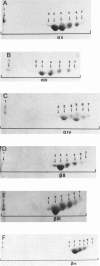Abstract
In a recent communication, we showed that human very low density lipoprotein (VLDL) apolipoprotein E (Apo E) from different individuals appears upon two-dimensional gel electrophoretic analysis in either one of two complex patterns. These have been designated class alpha and class beta. Mixing of VLDL from different subjects revealed that not all alpha or beta apo E patterns were the same. In this manner, we identified three subclasses of class alpha (alpha II, alpha III, and alpha IV) and three subclasses of class beta (beta II, beta III, and beta IV). We report here the results of family studies that reveal that the subclasses (alpha II, alph III, and alpha IV and beta II, beta III, and beta IV) of apo E are determined at a single genetic locus with three common alleles, epsilon II, epsilon III, and epsilon IV. The class beta phenotypes (beta II, beta III, and beta IV) represent homozygosity for two identical apo E alleles (epsilon). In contrast, class alpha phenotypes (alpha II, alpha III, and alpha IV) represent heterozygosity for two different apo E alleles. The apo E subclasses and their corresponding genotypes are as follows: beta II = epsilon II/epsilon II; beta III = epsilon III; beta IV = epsilon IV/epsilon IV; alpha II = epsilon II/epsilon III; alpha III = epsilon III/epsilon IV; and alpha IV = epsilon II/epsilon IV. To estimate the frequencies of the apo E alleles in the general population, apo E subclasses were then investigated in 61 unrelated volunteers and the results were: beta II = 1 (2%), beta III = 30 (49%), alpha II = 9 (15%, alpha III = 13 (31%), and alpha IV = 2 (3%). Utilizing the frequencies of these phenotypes, the gene frequencies were calculated to be epsilon II = 11%, epsilon III = 72%, and epsilon IV = 17%. In addition, apo E subclasses were studied in a clinic for individuals with plasma lipid disorders and the apo E subclass beta IV was found to be associated with type III hyperlipoproteinemia. There was no association of any apo E subclass with type II, type IV, or type VI hyperlipoproteinemia or plasma HDL cholesterol levels. This study explains the genetic basis for the common variation in a human plasma protein, apo E. Since the apo E subclass beta IV is associated with type III hyperlipoproteinemia, a disease characterized by xanthomatosis and premature atherosclerosis, understanding the genetic basis of the apo E subclasses should provide insight into the genetics of type III hyperlipoproteinemia.
Full text
PDF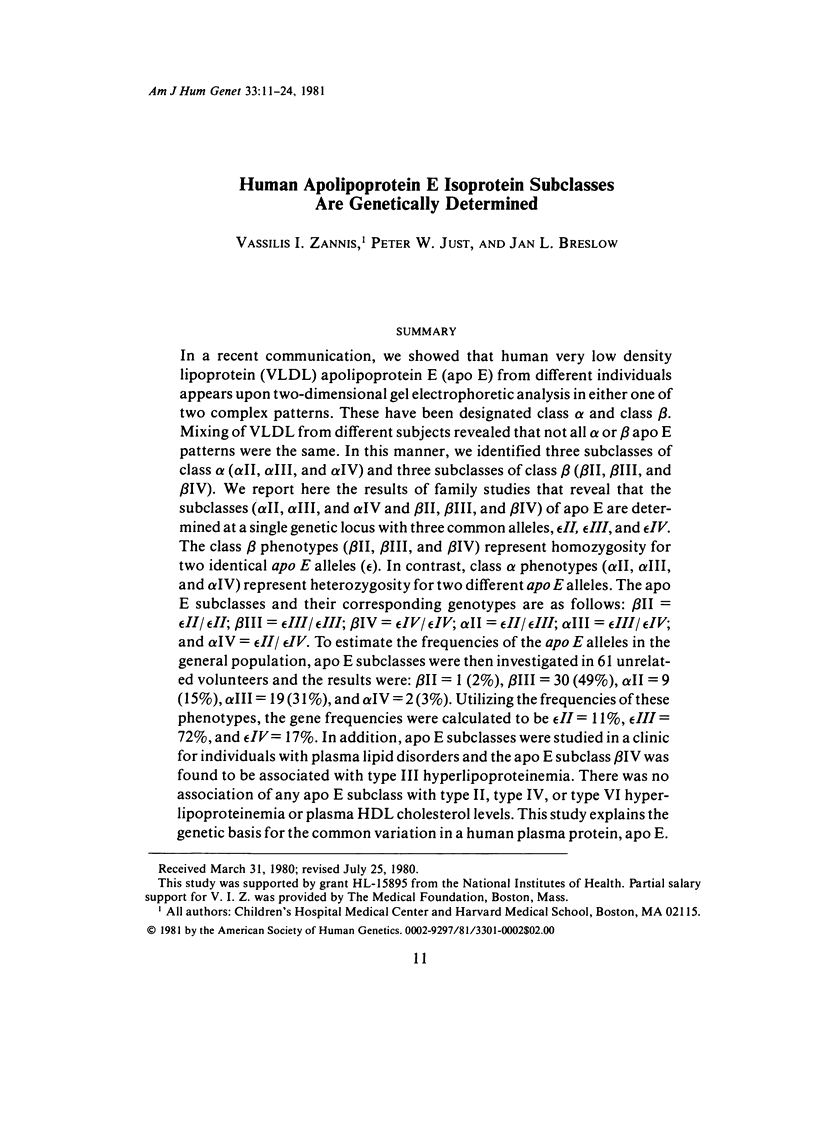
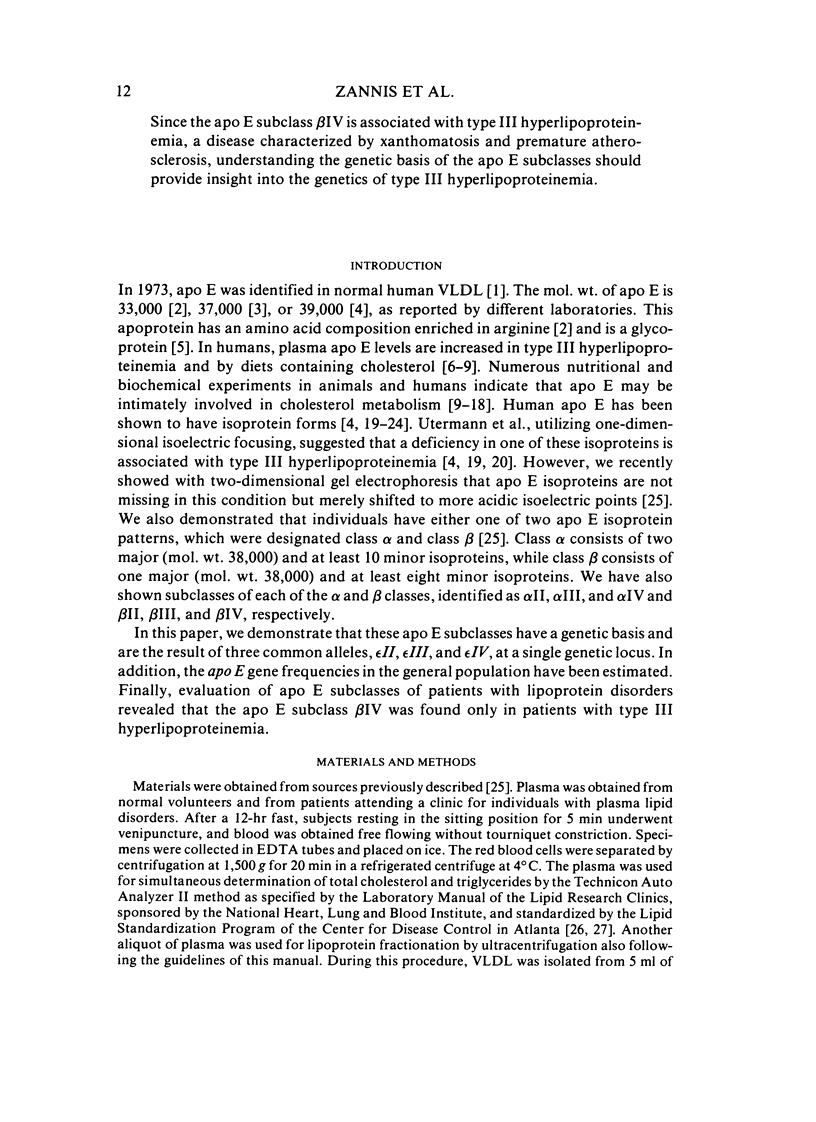
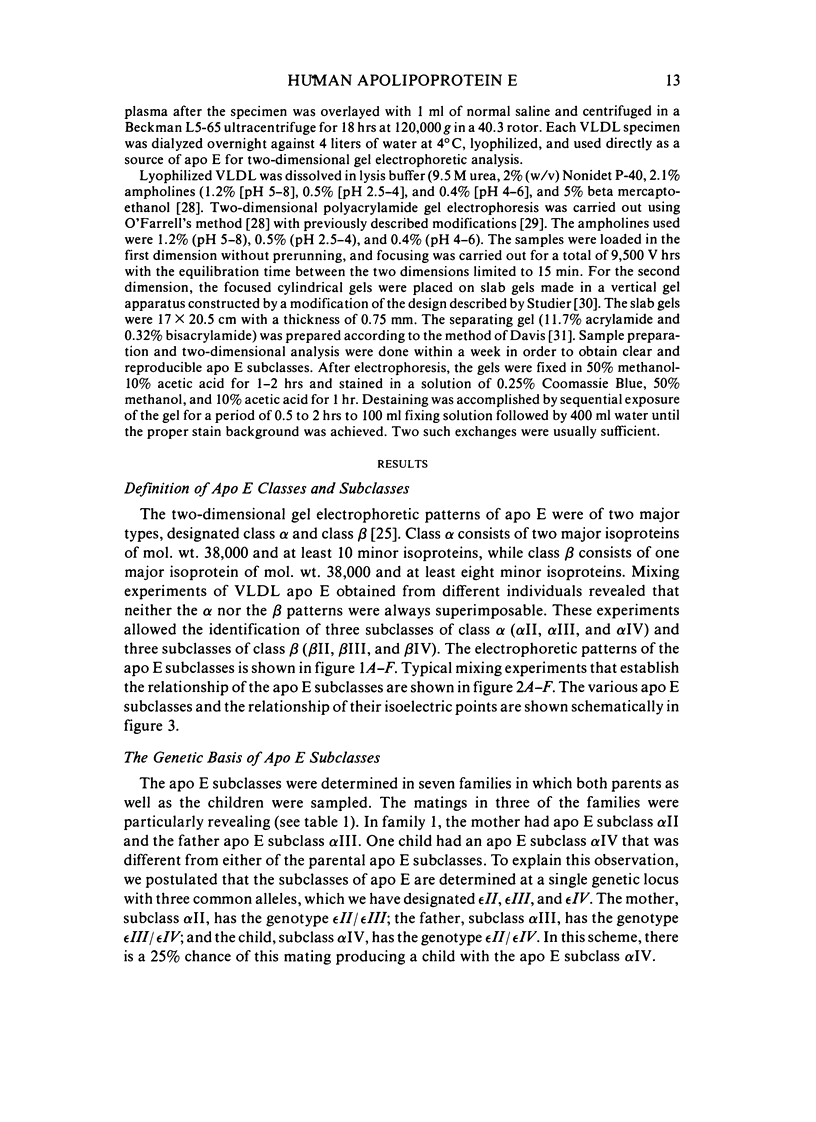
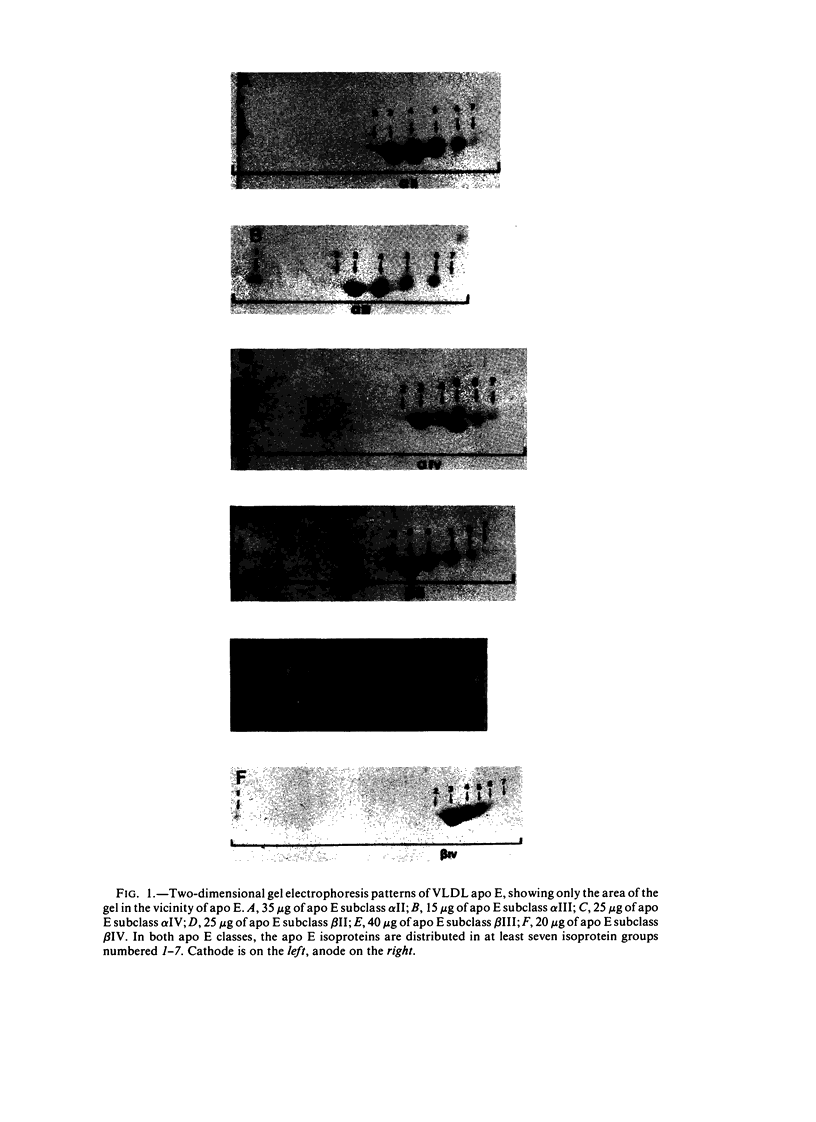
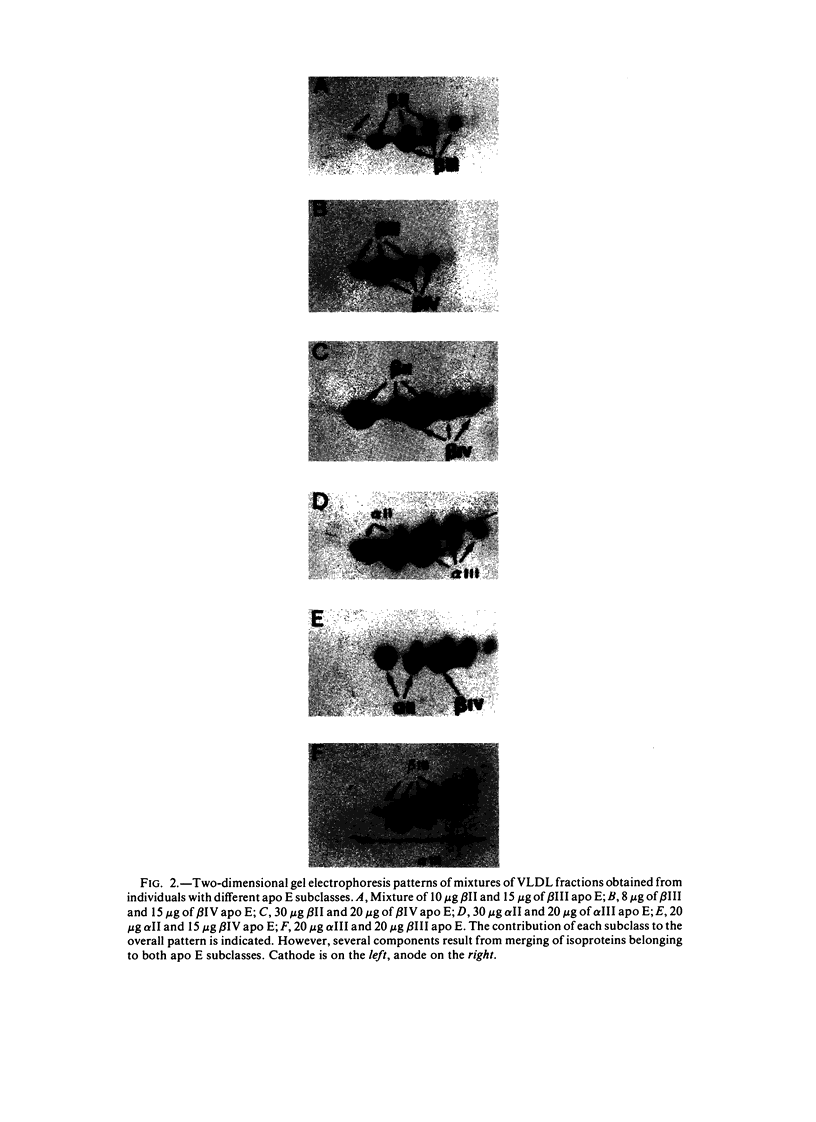
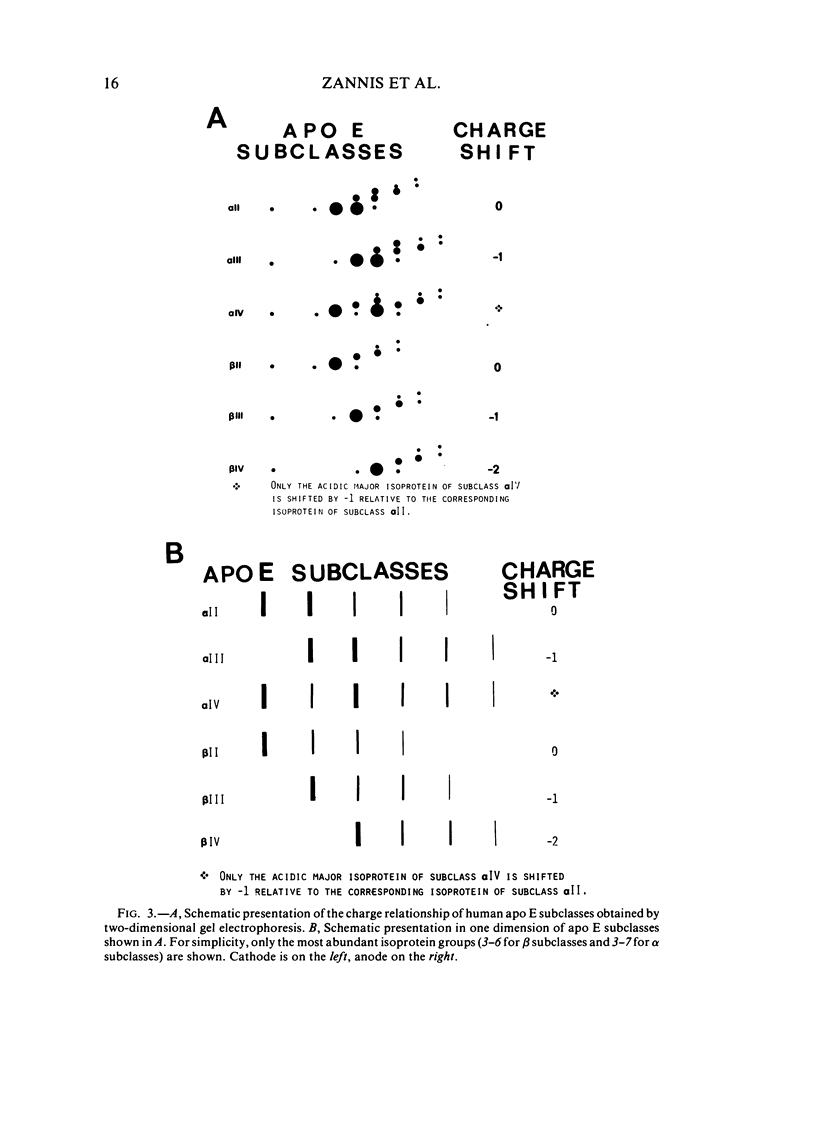
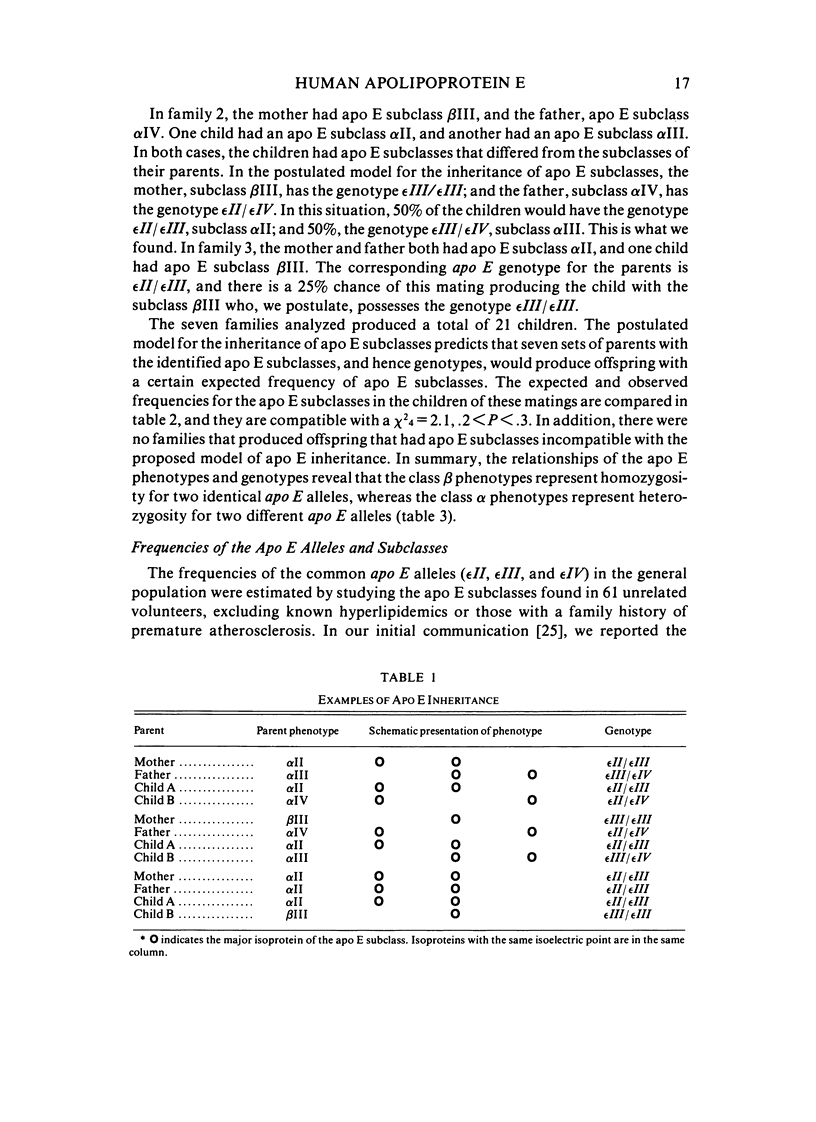
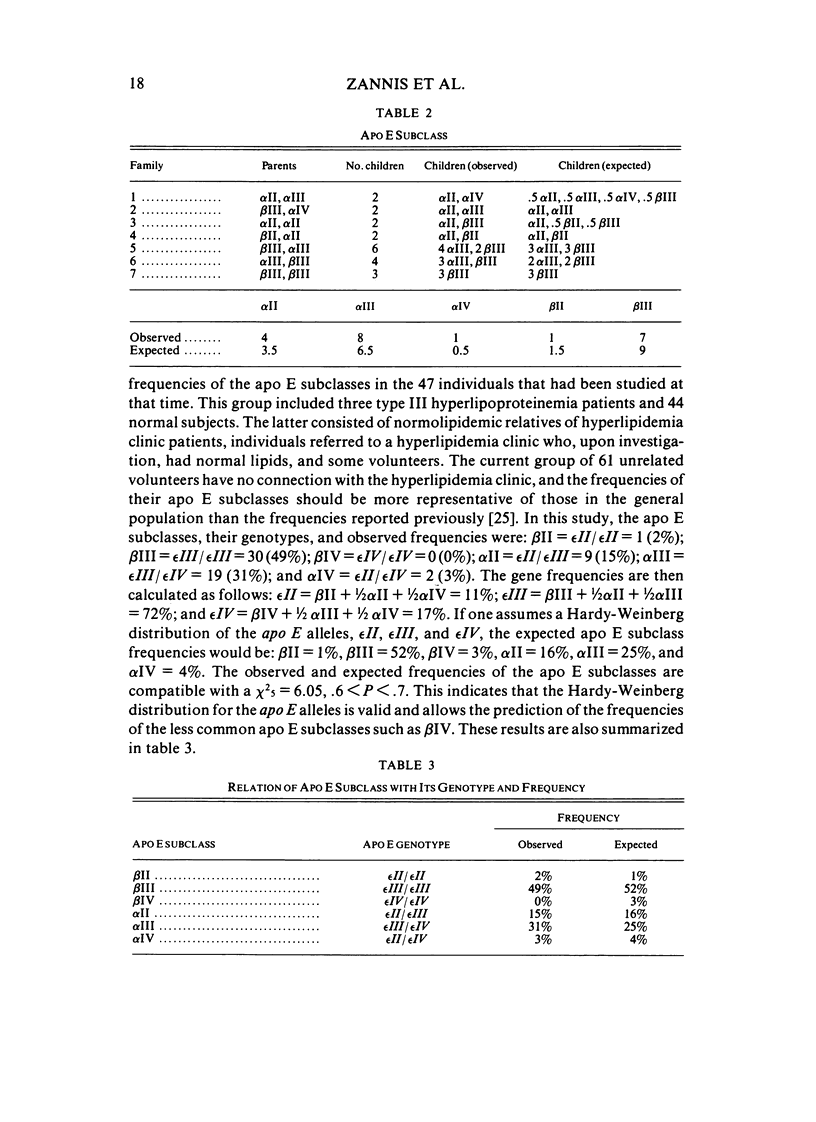
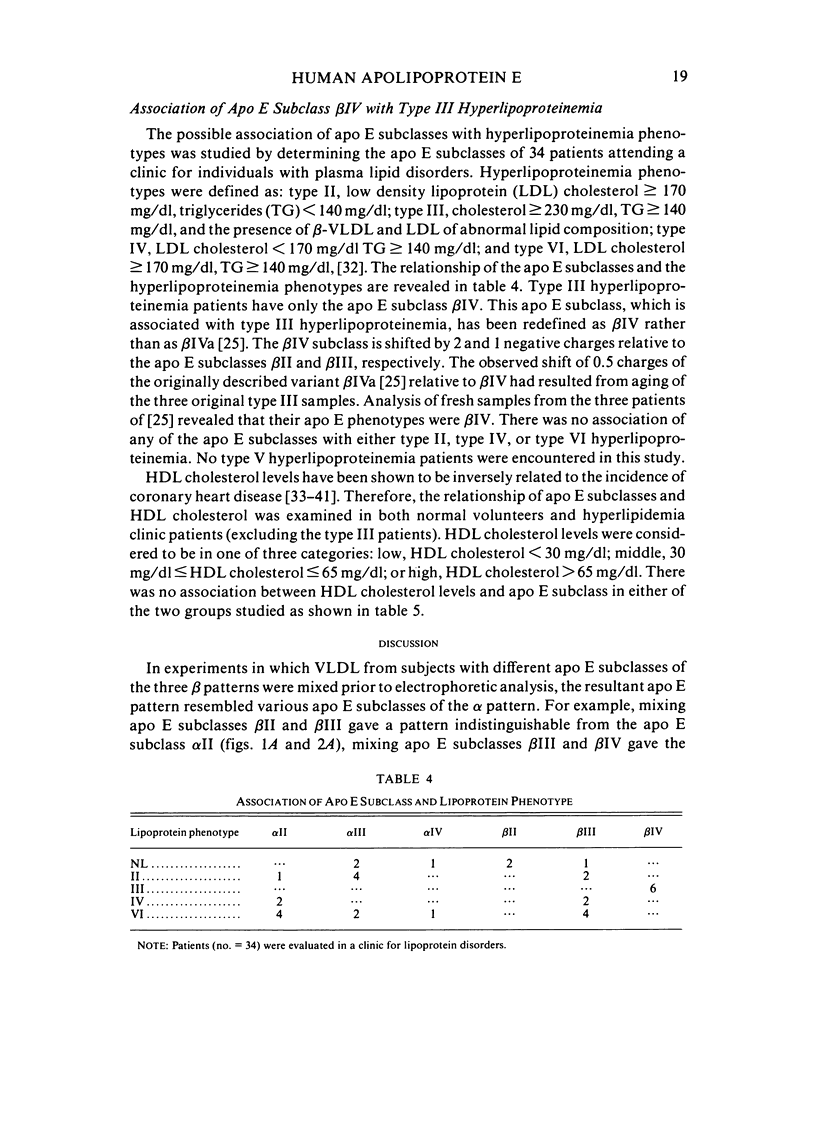
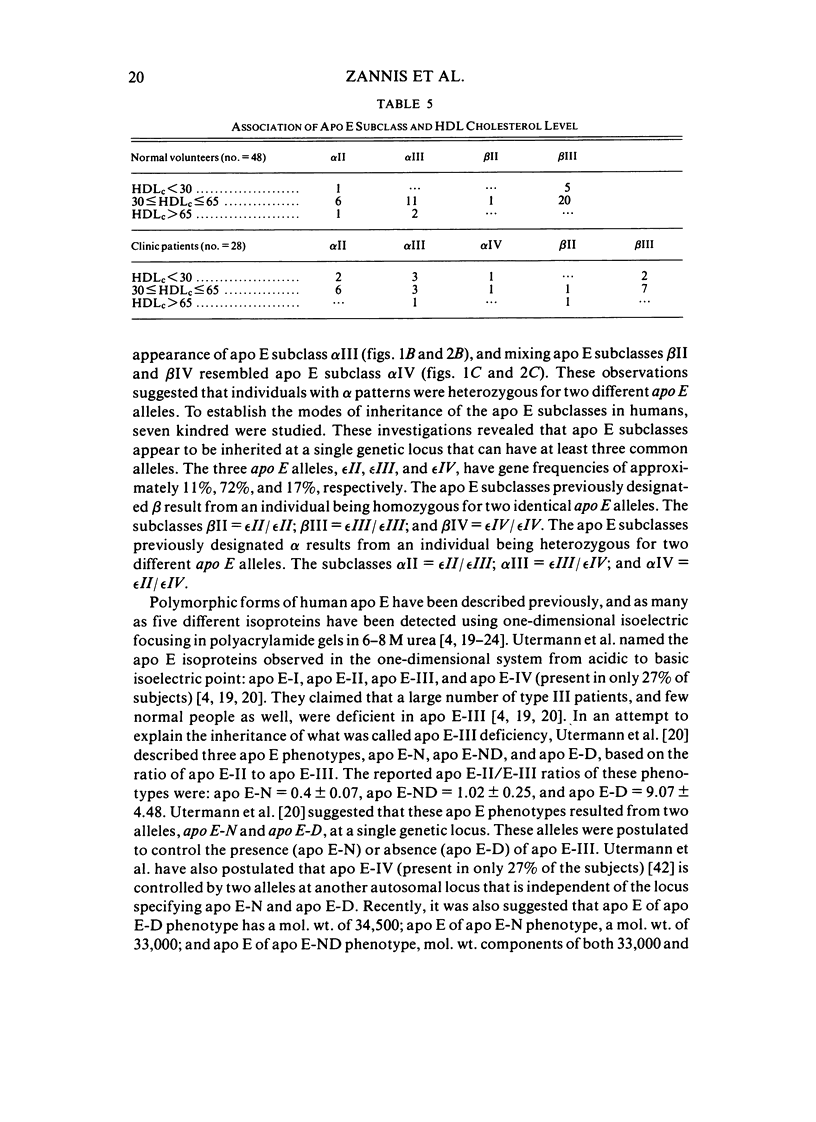
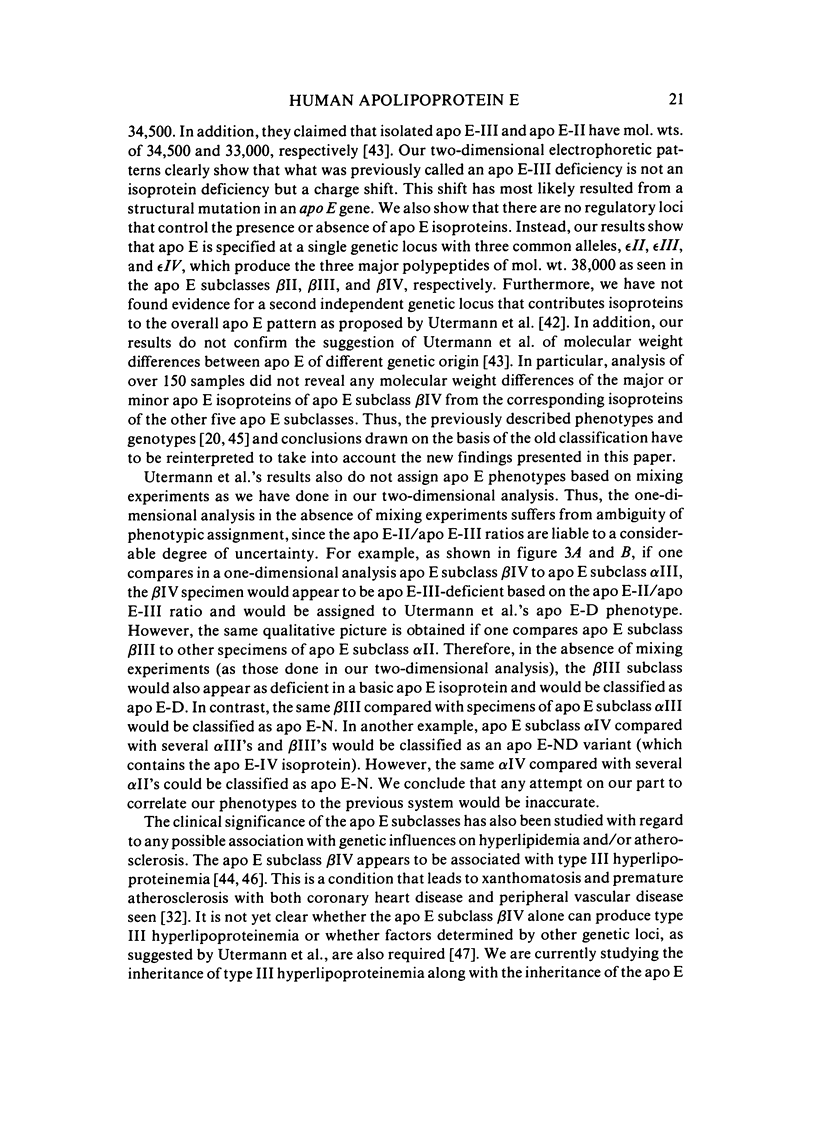
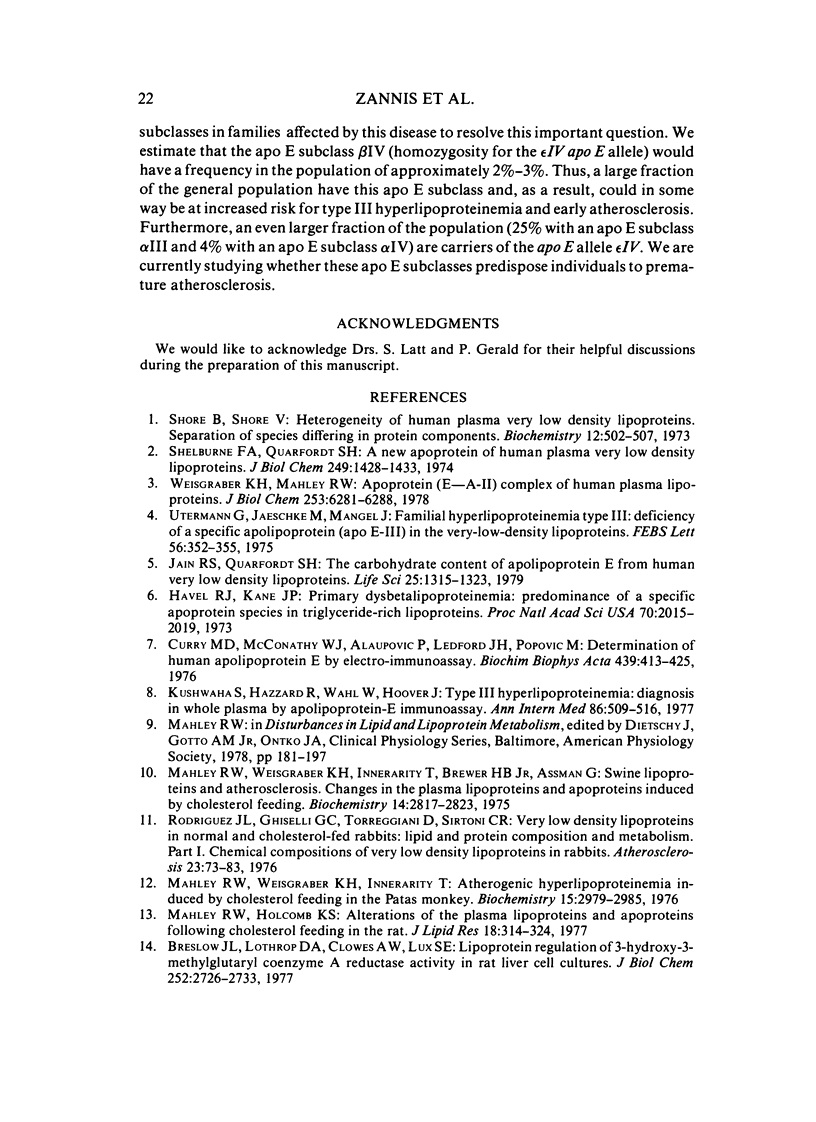
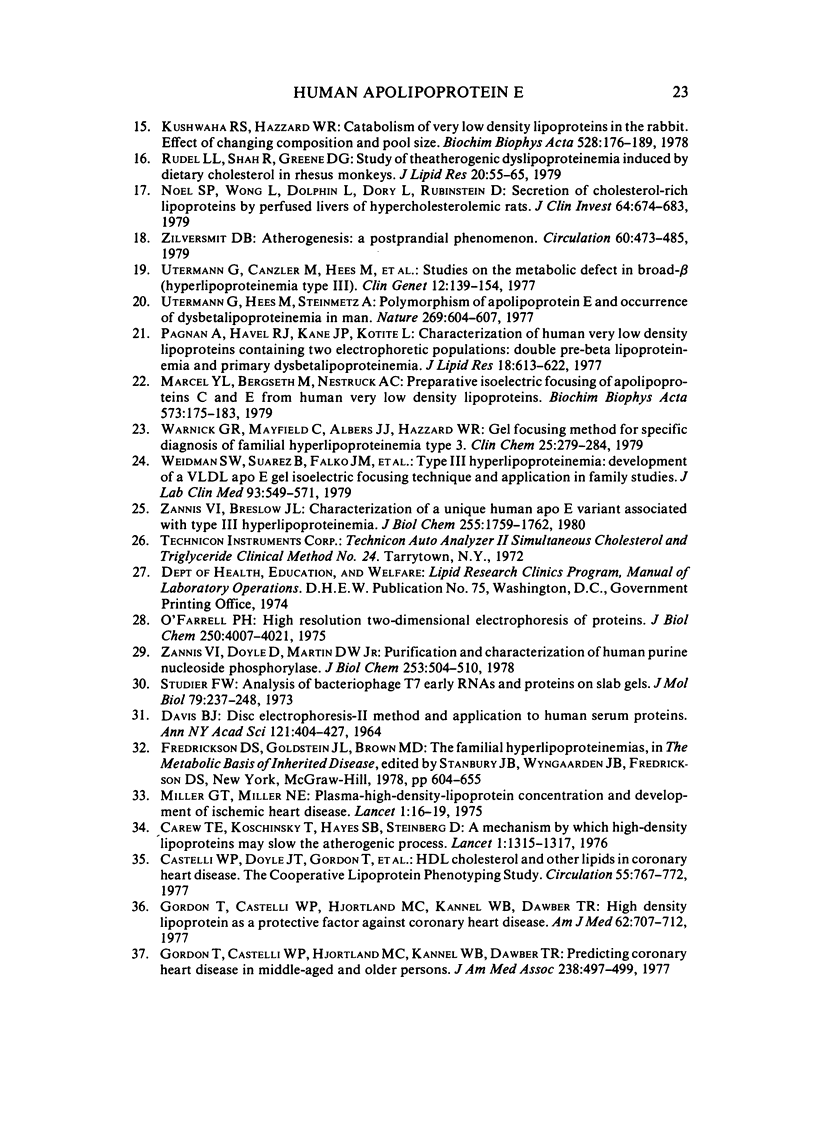
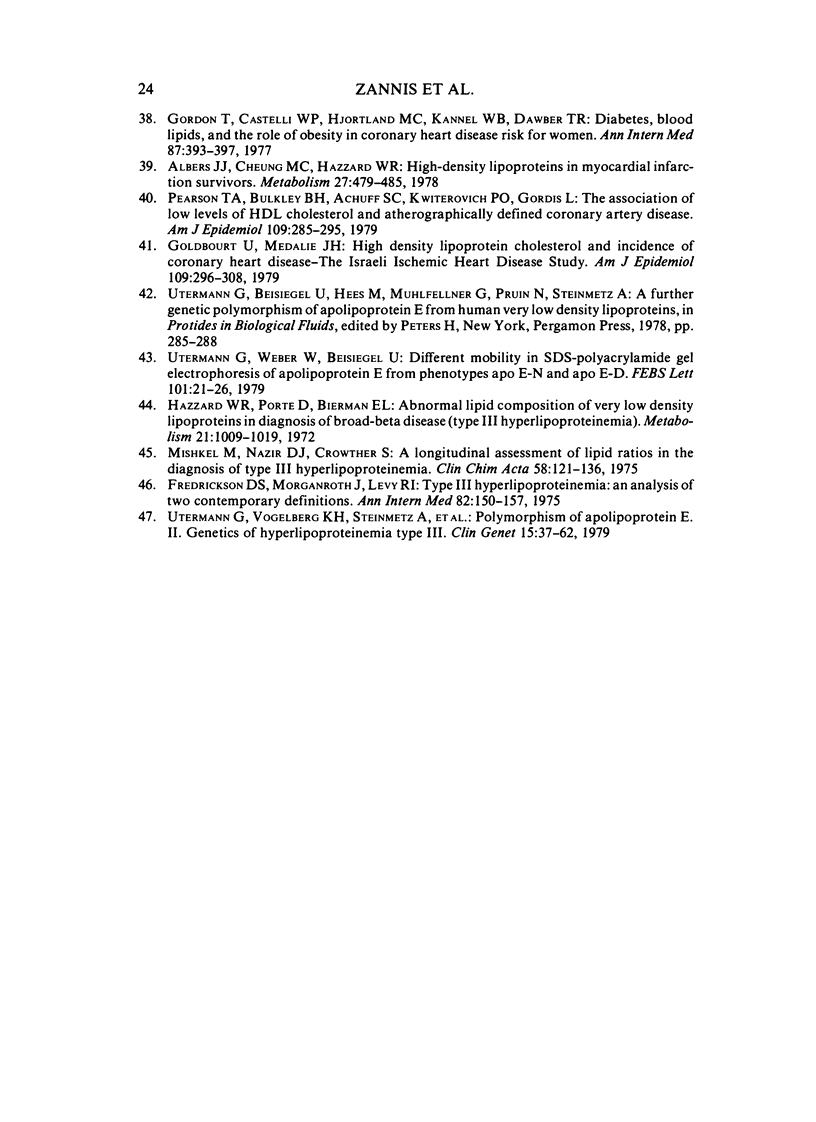
Images in this article
Selected References
These references are in PubMed. This may not be the complete list of references from this article.
- Albers J. J., Cheung M. C., Hazzard W. R. High-density lipoproteins in myocardial infarction survivors. Metabolism. 1978 Apr;27(4):479–485. doi: 10.1016/0026-0495(78)90102-6. [DOI] [PubMed] [Google Scholar]
- Breslow J. L., Lothrop D. A., Clowes A. W., Lux S. E. Lipoprotein regulation of 3-hydroxy-3-methylglutaryl coenzyme A reductase activity in rat liver cell cultures. J Biol Chem. 1977 Apr 25;252(8):2726–2733. [PubMed] [Google Scholar]
- Carew T. E., Koschinsky T., Hayes S. B., Steinberg D. A mechanism by which high-density lipoproteins may slow the atherogenic process. Lancet. 1976 Jun 19;1(7973):1315–1317. doi: 10.1016/s0140-6736(76)92650-7. [DOI] [PubMed] [Google Scholar]
- Castelli W. P., Doyle J. T., Gordon T., Hames C. G., Hjortland M. C., Hulley S. B., Kagan A., Zukel W. J. HDL cholesterol and other lipids in coronary heart disease. The cooperative lipoprotein phenotyping study. Circulation. 1977 May;55(5):767–772. doi: 10.1161/01.cir.55.5.767. [DOI] [PubMed] [Google Scholar]
- Curry M. D., McConathy W. J., Alaupovic P., Ledford J. H., Popović M. Determination of human apolipoprotein E by electroimmunoassay. Biochim Biophys Acta. 1976 Aug 9;439(2):413–425. doi: 10.1016/0005-2795(76)90078-7. [DOI] [PubMed] [Google Scholar]
- DAVIS B. J. DISC ELECTROPHORESIS. II. METHOD AND APPLICATION TO HUMAN SERUM PROTEINS. Ann N Y Acad Sci. 1964 Dec 28;121:404–427. doi: 10.1111/j.1749-6632.1964.tb14213.x. [DOI] [PubMed] [Google Scholar]
- Fredrickson D. S., Morganroth J., Levy R. I. Type III hyperlipoproteinemia: an analysis of two contemporary definitions. Ann Intern Med. 1975 Feb;82(2):150–157. doi: 10.7326/0003-4819-82-2-150. [DOI] [PubMed] [Google Scholar]
- Goldbourt U., Medalie J. H. High density lipoprotein cholesterol and incidence of coronary heart disease--the Israeli Ischemic Heart Disease Study. Am J Epidemiol. 1979 Mar;109(3):296–308. doi: 10.1093/oxfordjournals.aje.a112683. [DOI] [PubMed] [Google Scholar]
- Gordon T., Castelli W. P., Hjortland M. C., Kannel W. B., Dawber T. R. Diabetes, blood lipids, and the role of obesity in coronary heart disease risk for women. The Framingham study. Ann Intern Med. 1977 Oct;87(4):393–397. doi: 10.7326/0003-4819-87-4-393. [DOI] [PubMed] [Google Scholar]
- Gordon T., Castelli W. P., Hjortland M. C., Kannel W. B., Dawber T. R. High density lipoprotein as a protective factor against coronary heart disease. The Framingham Study. Am J Med. 1977 May;62(5):707–714. doi: 10.1016/0002-9343(77)90874-9. [DOI] [PubMed] [Google Scholar]
- Gordon T., Castelli W. P., Hjortland M. C., Kannel W. B., Dawber T. R. Predicting coronary heart disease in middle-aged and older persons. The Framington study. JAMA. 1977 Aug 8;238(6):497–499. [PubMed] [Google Scholar]
- Havel R. J., Kane J. P. Primary dysbetalipoproteinemia: predominance of a specific apoprotein species in triglyceride-rich lipoproteins. Proc Natl Acad Sci U S A. 1973 Jul;70(7):2015–2019. doi: 10.1073/pnas.70.7.2015. [DOI] [PMC free article] [PubMed] [Google Scholar]
- Hazzard W. R., Porte D., Jr, Bierman E. L. Abnormal lipid composition of very low density lipoproteins in diagnosis of broad-beta disease (type 3 hyperlipoproteinemia). Metabolism. 1972 Nov;21(11):1009–1019. doi: 10.1016/0026-0495(72)90031-5. [DOI] [PubMed] [Google Scholar]
- Jain R. S., Quarfordt S. H. The carbohydrate content of apolipoprotein E from human very low density lipoproteins. Life Sci. 1979 Oct 8;25(15):1315–1323. doi: 10.1016/0024-3205(79)90397-7. [DOI] [PubMed] [Google Scholar]
- Kushwaha R. S., Hazzard W. R. Catabolism of very low density lipoproteins in the rabbit. Effect of changing composition and pool size. Biochim Biophys Acta. 1978 Feb 27;528(2):176–189. doi: 10.1016/0005-2760(78)90192-3. [DOI] [PubMed] [Google Scholar]
- Mahley R. W., Holcombe K. S. Alterations of the plasma lipoproteins and apoproteins following cholesterol feeding in the rat. J Lipid Res. 1977 May;18(3):314–324. [PubMed] [Google Scholar]
- Mahley R. W., Weisgraber K. H., Innerarity T. Atherogenic hyperlipoproteinemia induced by cholesterol feeding the Patas monkey. Biochemistry. 1976 Jul 13;15(14):2979–2985. doi: 10.1021/bi00659a007. [DOI] [PubMed] [Google Scholar]
- Mahley R. W., Weisgraber K. H., Innerarity T., Brewer H. B., Jr, Assmann G. Swine lipoproteins and atherosclerosis. Changes in the plasma lipoproteins and apoproteins induced by cholesterol feeding. Biochemistry. 1975 Jul;14(13):2817–2823. doi: 10.1021/bi00684a005. [DOI] [PubMed] [Google Scholar]
- Marcel Y. L., Bergseth M., Nestruck A. C. Preparative isoelectric focussing of apolipoproteins C and E from human very low density lipoproteins. Biochim Biophys Acta. 1979 Apr 27;573(1):175–183. doi: 10.1016/0005-2760(79)90184-x. [DOI] [PubMed] [Google Scholar]
- Miller G. J., Miller N. E. Plasma-high-density-lipoprotein concentration and development of ischaemic heart-disease. Lancet. 1975 Jan 4;1(7897):16–19. doi: 10.1016/s0140-6736(75)92376-4. [DOI] [PubMed] [Google Scholar]
- Mishkel M. A., Nazir D. J., Crowther S. A longitudinal assessment of lipid ratios in the diagnosis of type III hyperlipoproteinaemia. Clin Chim Acta. 1975 Jan 20;58(2):121–136. doi: 10.1016/s0009-8981(75)80004-0. [DOI] [PubMed] [Google Scholar]
- Noel S. P., Wong L., Dolphin P. J., Dory L., Rubenstein D. Secretion of cholesterol-rich lipoproteins by perfused livers of hypercholesterolemic rats. J Clin Invest. 1979 Aug;64(2):674–683. doi: 10.1172/JCI109508. [DOI] [PMC free article] [PubMed] [Google Scholar]
- O'Farrell P. H. High resolution two-dimensional electrophoresis of proteins. J Biol Chem. 1975 May 25;250(10):4007–4021. [PMC free article] [PubMed] [Google Scholar]
- Pagnan A., Havel R. J., Kane J. P., Kotite L. Characterization of human very low density lipoproteins containing two electrophoretic populations: double pre-beta lipoproteinemia and primary dysbetalipoproteinemia. J Lipid Res. 1977 Sep;18(5):613–622. [PubMed] [Google Scholar]
- Pearson T. A., Bulkley B. H., Achuff S. C., Kwiterovich P. O., Gordis L. The association of low levels of HDL cholesterol and arteriographically defined coronary artery disease. Am J Epidemiol. 1979 Mar;109(3):285–295. doi: 10.1093/oxfordjournals.aje.a112682. [DOI] [PubMed] [Google Scholar]
- Rodriguez J. L., Ghiselli G. C., Torreggiani D., Sirtori C. R. Very low density lipoproteins in normal and cholesterol-fed rabbits: lipid and protein composition and metabolism. Part 1. Chemical composition of very low density lipoproteins in rabbits. Atherosclerosis. 1976 Jan-Feb;23(1):73–83. doi: 10.1016/0021-9150(76)90119-2. [DOI] [PubMed] [Google Scholar]
- Rudel L. L., Shah R., Greene D. G. Study of the atherogenic dyslipoproteinemia induced by dietary cholesterol in rhesus monekys (Macaca mulatta). J Lipid Res. 1979 Jan;20(1):55–65. [PubMed] [Google Scholar]
- Shelburne F. A., Quarfordt S. H. A new apoprotein of human plasma very low density lipoproteins. J Biol Chem. 1974 Mar 10;249(5):1428–1433. [PubMed] [Google Scholar]
- Shore V. G., Shore B. Heterogeneity of human plasma very low density lipoproteins. Separation of species differing in protein components. Biochemistry. 1973 Jan 30;12(3):502–507. doi: 10.1021/bi00727a022. [DOI] [PubMed] [Google Scholar]
- Studier F. W. Analysis of bacteriophage T7 early RNAs and proteins on slab gels. J Mol Biol. 1973 Sep 15;79(2):237–248. doi: 10.1016/0022-2836(73)90003-x. [DOI] [PubMed] [Google Scholar]
- Utermann G., Canzler H., Hees M., Jaeschke M., Mühlfellner G., Schoenborn W., Vogelberg K. H. Studies on the metabolic defect in Broad-beta disease (hyperlipoproteinaemia type III). Clin Genet. 1977 Sep;12(3):139–154. doi: 10.1111/j.1399-0004.1977.tb00917.x. [DOI] [PubMed] [Google Scholar]
- Utermann G., Hees M., Steinmetz A. Polymorphism of apolipoprotein E and occurrence of dysbetalipoproteinaemia in man. Nature. 1977 Oct 13;269(5629):604–607. doi: 10.1038/269604a0. [DOI] [PubMed] [Google Scholar]
- Utermann G., Jaeschke M., Menzel J. Familial hyperlipoproteinemia type III: deficiency of a specific apolipoprotein (apo E-III) in the very-low-density lipoproteins. FEBS Lett. 1975 Aug 15;56(2):352–355. doi: 10.1016/0014-5793(75)81125-2. [DOI] [PubMed] [Google Scholar]
- Utermann G., Vogelberg K. H., Steinmetz A., Schoenborn W., Pruin N., Jaeschke M., Hees M., Canzler H. Polymorphism of apolipoprotein E. II. Genetics of hyperlipoproteinemia type III. Clin Genet. 1979 Jan;15(1):37–62. [PubMed] [Google Scholar]
- Utermann G., Weber W., Beisiegel U. Different mobility in SDS--polyacrylamide gel electrophoresis of apolipoprotein E from phenotypes apo E-N and Apo E-D. FEBS Lett. 1979 May 1;101(1):21–26. [PubMed] [Google Scholar]
- Warnick G. R., Mayfield C., Albers J. J., Hazzard W. R. Gel isoelectric focusing method for specific diagnosis of familial hyperlipoproteinemia type 3. Clin Chem. 1979 Feb;25(2):279–284. [PubMed] [Google Scholar]
- Weidman S. W., Suarez B., Falko J. M., Witztum J. L., Kolar J., Raben M., Schonfeld G. Type III hyperlipoproteinemia: development of a VLDL ApoE gel isoelectric focusing technique and application in family studies. J Lab Clin Med. 1979 Apr;93(4):549–569. [PubMed] [Google Scholar]
- Weisgraber K. H., Mahley R. W. Apoprotein (E--A-II) complex of human plasma lipoproteins. I. Characterization of this mixed disulfide and its identification in a high density lipoprotein subfraction. J Biol Chem. 1978 Sep 10;253(17):6281–6288. [PubMed] [Google Scholar]
- Zannis V. I., Breslow J. L. Characterization of a unique human apolipoprotein E variant associated with type III hyperlipoproteinemia. J Biol Chem. 1980 Mar 10;255(5):1759–1762. [PubMed] [Google Scholar]
- Zannis V., Doyle D., Martin D. W., Jr Purification and characterization of human erythrocyte purine nucleoside phosphorylase and its subunits. J Biol Chem. 1978 Jan 25;253(2):504–510. [PubMed] [Google Scholar]
- Zilversmit D. B. Atherogenesis: a postprandial phenomenon. Circulation. 1979 Sep;60(3):473–485. doi: 10.1161/01.cir.60.3.473. [DOI] [PubMed] [Google Scholar]



